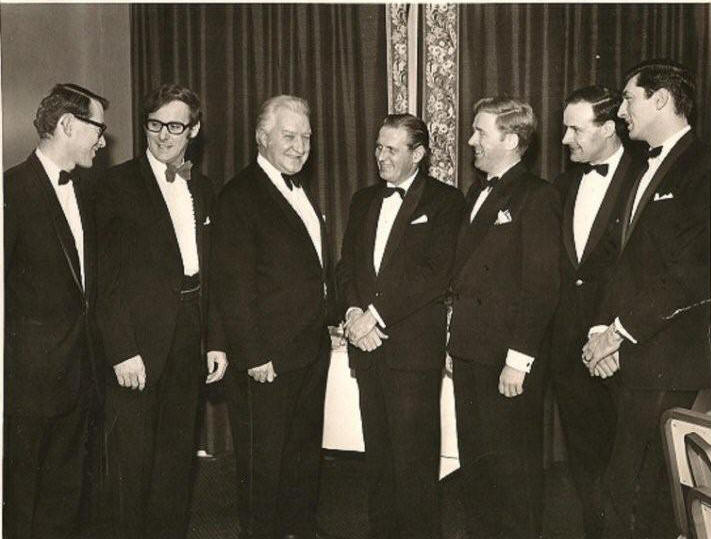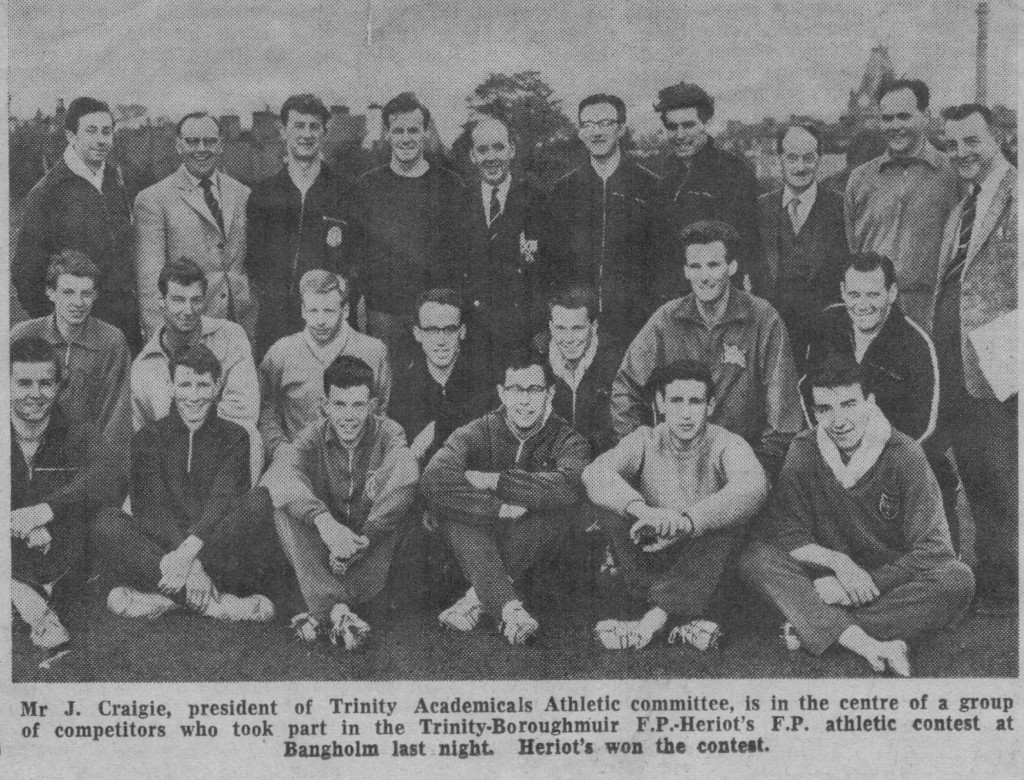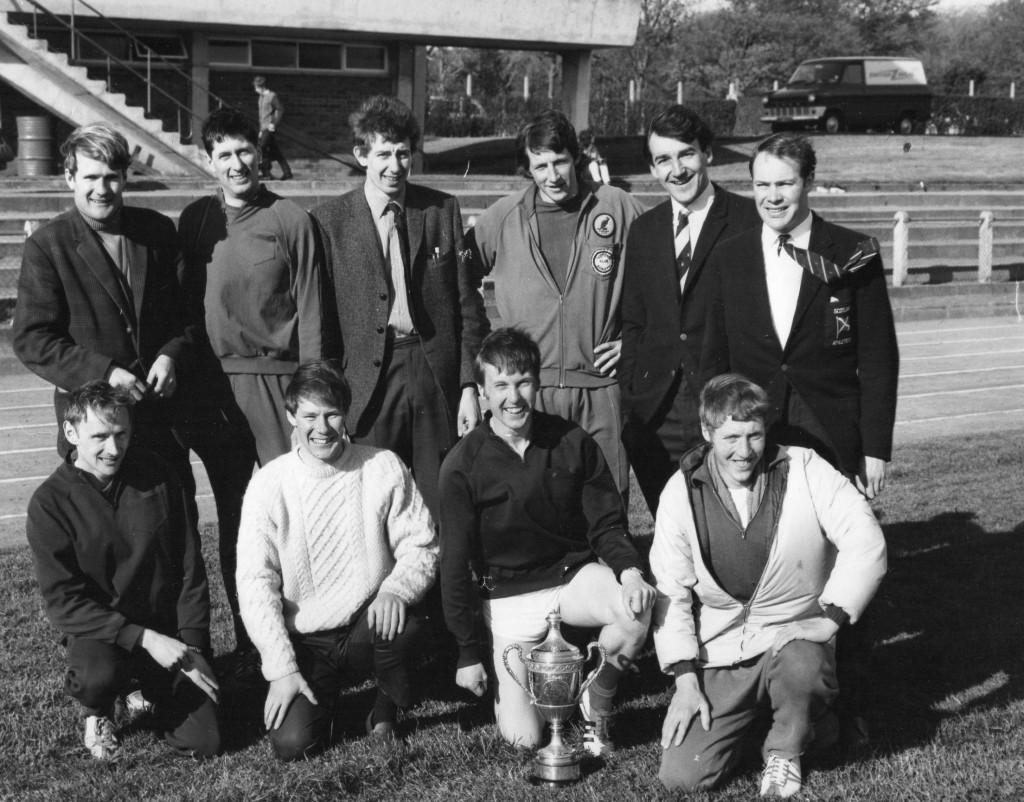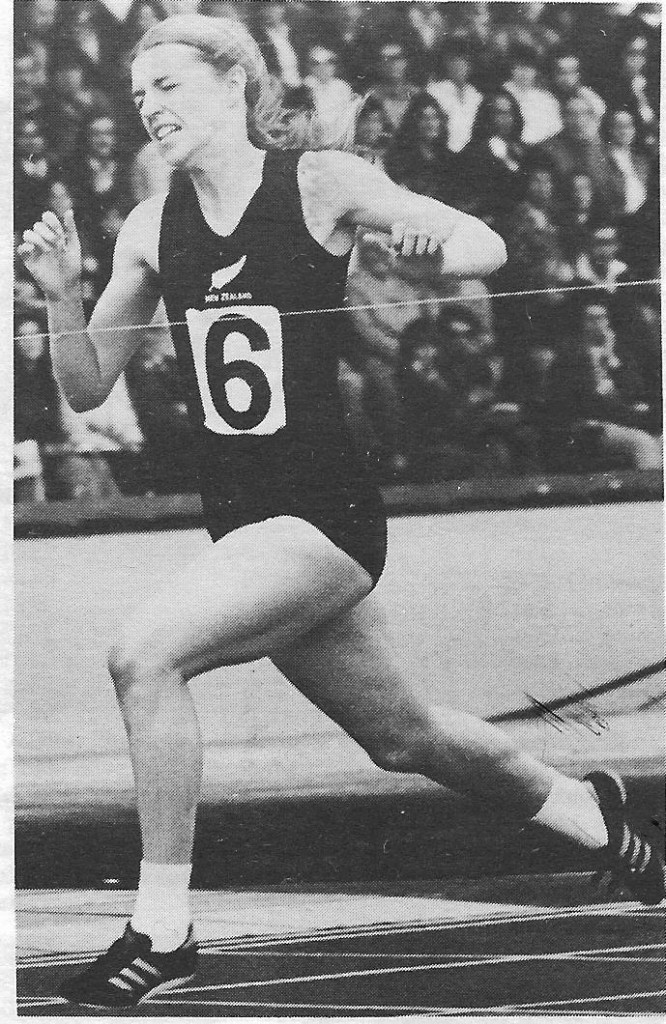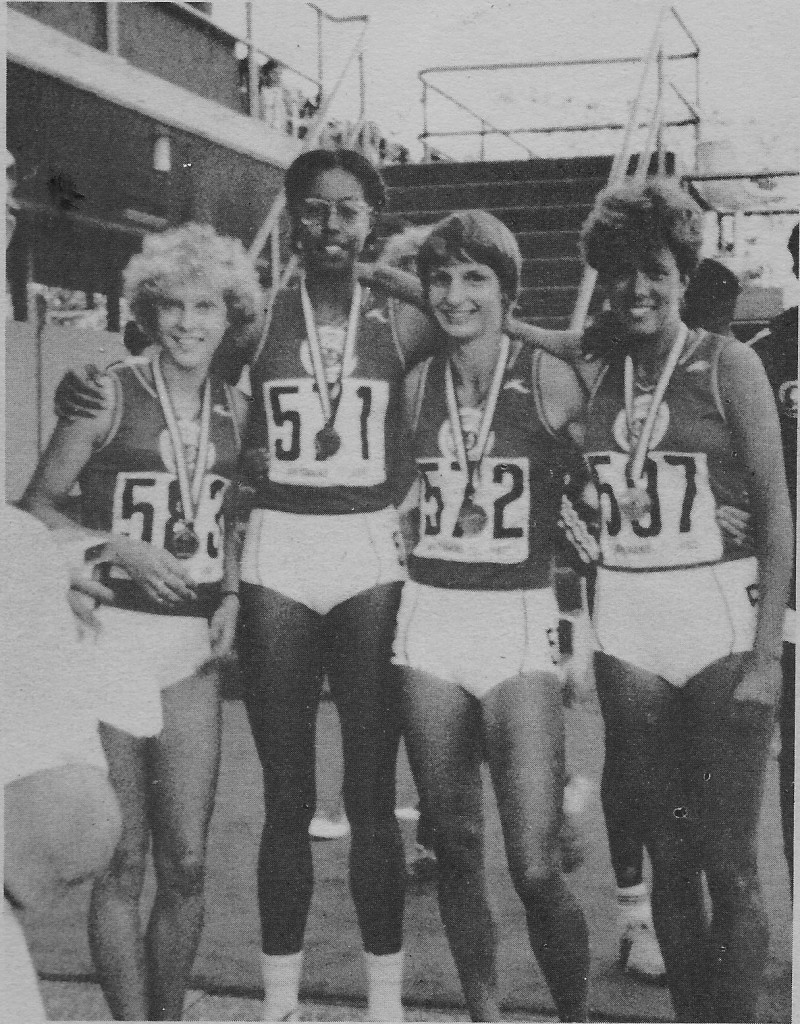Ian Grant, John Jones, Rab Foreman, George Sinclair, Ken Hutcheson, Tom Tait and John Turnbull
George Sinclair is one of the best – and at the same time one of the least known – coaches in the country. He has worked with several of the very best athletes the country has produced. As an announcer, his voice has been heard and listened closely to by almost everyone in Scottish athletics: he was employed in that capacity at the Commonwealth Games. He is however almost unknown outside Edinburgh
A pupil at George Heriot’s School all the way up from primary to secondary level George competed for them as a sprinter and high jumper. In 1971, his enthusiasm for the sport, led to him being one of the founders of the very successful Octavians Athletic Club.
George is on the extreme right of the middle row
Octavians was formed in 1962 and was an amalgamation of eight of the Edinburgh fee paying’ schools, former pupils athletic clubs. Due to falling numbers and a consequent drop in standards, representatives of George Heriot’s School , Royal High School , Daniel Stewart’s College, Trinity Academy , George Watson’s College, Edinburgh Academy, Boroughmuir High Schoo and Melville College met and the club was formed. George was the club president. Members were to include two Olympians (David Stevenson and David Jenkins), Commonwealth Games athletes (add John Jones and Ian Grant), GB internationalists (add Bob Hay, Adrian Weatherhead, Gordon Rule and Frank Dick) and many Scottish internationalists. There is a comprehensive list of members at their website (address below).
Octavians produced, or developed, many quite outstanding athletes. Robin Morris, a pupil at George Watson’s, was one of the early members of the club, running for Octavians before he left school in 1967 in the Scottish National League at the new track at Grangemouth as well as turning out in Trophy Meetings for the club. George ran the Post Office at Goldenacre and coached many internationalists from the Edinburgh Southern Harriers club at Saughton and Fernieside as well as advising many young members. Robin also tells us that the club moved to start training at New Meadowbank before the stadium was officially opened in 1970 but two of his biggest memories of Octavians were winning the Land of Burns Trophy at Dam Park in 1969 and the formal winding up dinner at the Balmoral Hotel !
The ‘Land O’Burns Trophy winning team:
Back row: Donald Burr (team manager), John Turnbull, A.N.Other, Peter Burgess, Tony Hogarth, Mike Bathgate. Front row: Tommy Tait, Stewart Seale, Adrian Weatherhead, Robin Morris.
Distinguished international middle and long distance runner Adrian Weatherhead says that George was the first coach to give him advice when he joined Octavians in 1963. Adrian goes on to say that George also coached Tony Hogarth and Tommy Tait:
* Adrian was a sub four miler, GB and Scotland international runner indoors and out, on the track and over the country;
* Tony won 5 SAAA hurdles titles over 110m, 120 yards and 440 yards between 1964 and 1969;
* Tommy was a top class sprinter, hurdler and long jumper with a long career going from 1960 to 1975.
and of course there were others.
The success of the club can be easily seen by checking out the ranking lists and international team personnel of the period. There was an emphasis on the explosive and technical events – other than Adrian, their representation in the distance events was scanty. If we take, as an example, the lists of 1969 we see that George’s athlete Tony Hogarth had six of the top eight times for 110m hurdles and seven of the top 21 as well as winning the Scottish and East District championships; in the pole vault, David Stevenson and Stewart Seale had the top ten times between them, Peter Burgess had first, fourth, sixth and seventh decathlon performances, Adrian Weatherhead was ranked in 800m/1500m/Mile, 3000m and 5000m, and the list indicates Octavians ranked in the 100m (3), 200m (1), 400m (4), 800m (1), 1500m (1), 5000m (1), 110m H (4), 400m H (3), HJ (1), PV (5), LJ (2), TJ (-), Discus (2), Hammer (-), Javelin (1), and Decathlon (3).
George’s athletes contributed strongly to these performances – Hogarth was the stand out of course topping the all-time lists, winning the SAAA Championships, almost monopolising the ranking lists, Tommy Tait was ranked in 100m, 200m, 400m, and ran in both relays.
With the standard within the club so high, why did the club fold up only two years later? The Octavians AC website is at www.octaviansac.co.uk and it tells us that –
“The Club became a victim of its own success, as the team was principally made up of District and National Champions and both Scottish and G.B. Internationals, as a result youngsters found that they could not get into the team; so they went elsewhere. The Club folded in 1971 then, after providing two trophies – one in the form of a baton for the Octavian Relays at Grangemouth, the other a Sword to be awarded annually at the Carnethy Hill Race meeting ( won by club member Robin Morris)”
The photograph at the top of the page was taken at the wind-up Dinner on 16th December 1971 at the Balmoral Hotel, Edinburgh. Members of the club then went in the main to one or other of the two big clubs in the capital, with George joining up with Edinburgh Southern Harriers.
Helen Golden
Edinburgh had many athletic clubs at this point but two big ones: the newer Edinburgh AC (established in 1962) challenging the dominant Edinburgh Southern Harriers which was one of the very best Scottish clubs. When Octavians went out of business their funds went to Edinburgh AC and their name was perpetuated in the very successful but now defunct Octavian Relays Meeting run by EAC.
George continued to coach athletes very successfully and one of the very best was Helen Golden, British and Scottish sprinter of very high quality indeed right from the very start as a girl running for ESH in 1965 until she retired from sprinting in 1980. The range of George’s coaching talents has already been indicated – sprints, hurdles, middle distance, long and triple jumps have all been mentioned already and another top class athlete who came under his influence was Anne Purvis.
Scottish 4 x 400 relay team, 1982: Lynsey McDonald, Angela Bridgman, Anne Clarkson (Purvis), Sandra Whittaker.
She says, “I started training with George when I was 14 in 1973. He was then Head Coach of Edinburgh Southern Harriers. He coached a number of athletes from sprints to Middle Distance. The athletes I trained with then were Helen Golden, Mary Munroe, Annie Littlejohn, Elaine Douglas and Fiona Macaulay.
George did not believe in over-training young athletes, so I only trained at a maximum of 3 times a week which gradually increased over the years eventually 6 days a week often twice a day. His training was always specifically targeted for competition either club, championships or international. George was always keen to learn as a coach and apply new ideas to your training. He always attended the Coaches Conventions organised by Frank Dick and would listen to other coaches.
He was also happy for you to train with other coaches as he arranged training sessions for me with Donny McLeod’s squad for elastic strength work in the winter and Bill Walker’s squad for quality sessions in the summer. Over the years a number of other athletes came to him for coaching including Katherine Shepperd and Fiona Hargreaves. All the athletes I have mentioned became Scottish Internationalists, some also competing for Great Britain.
